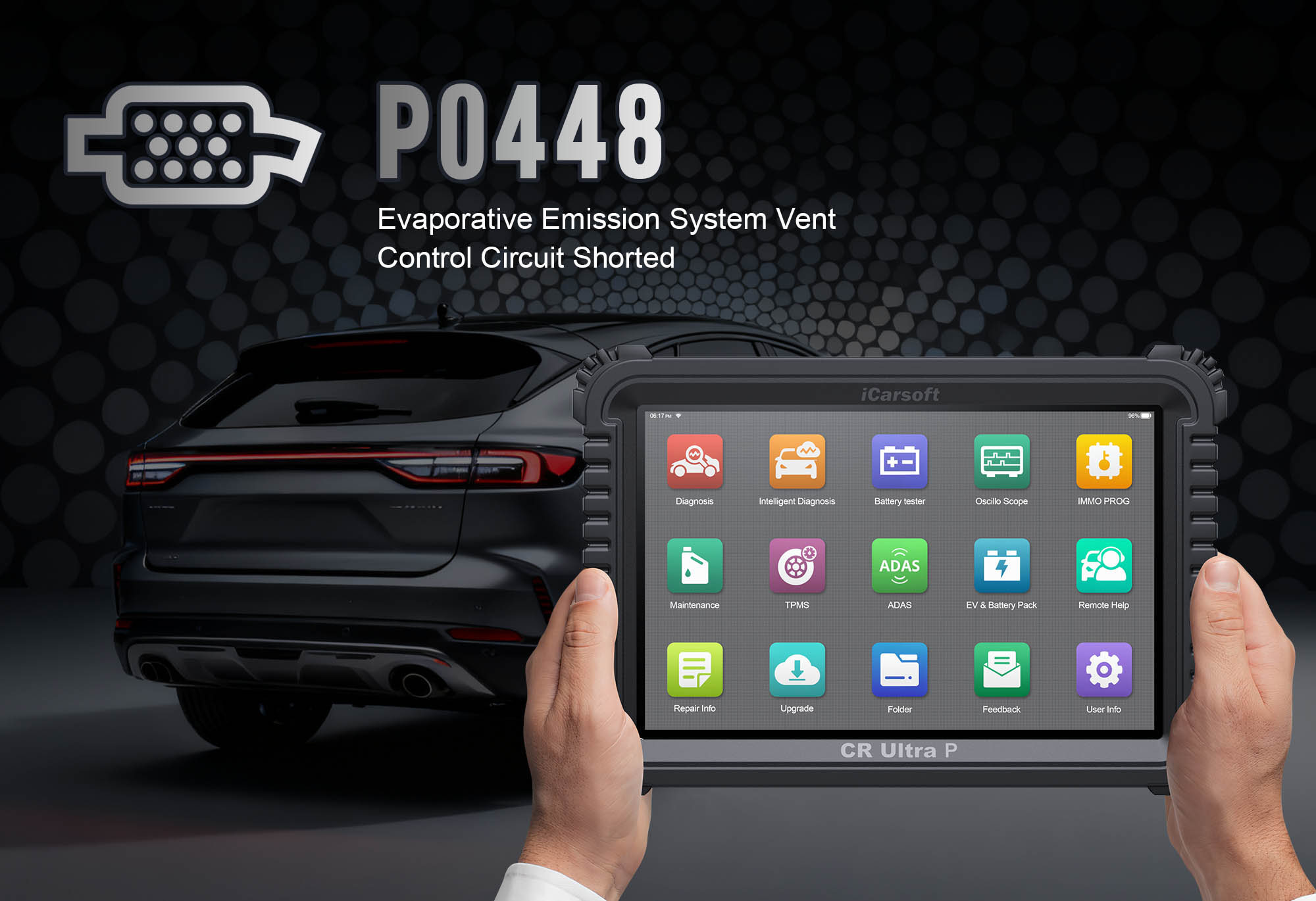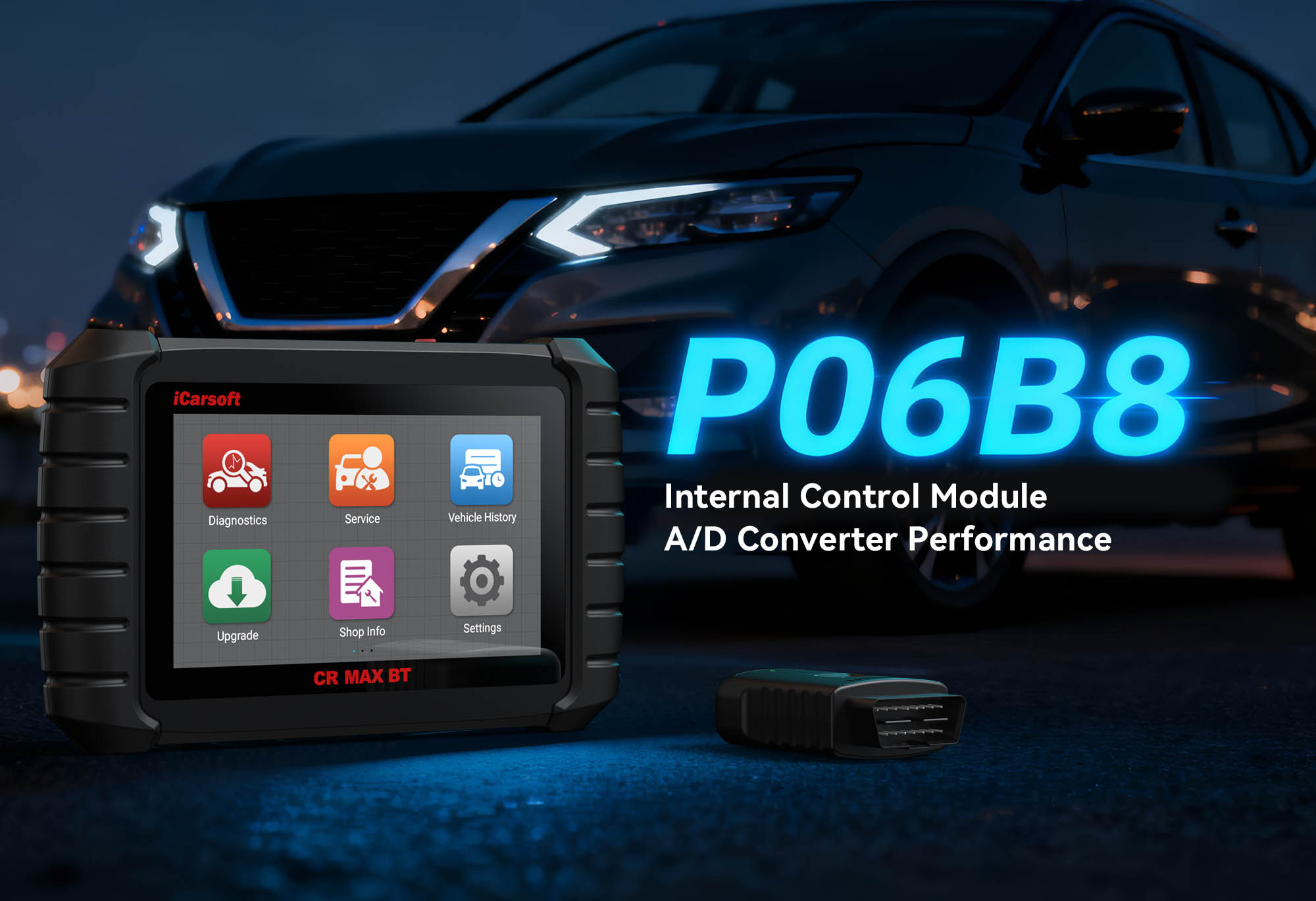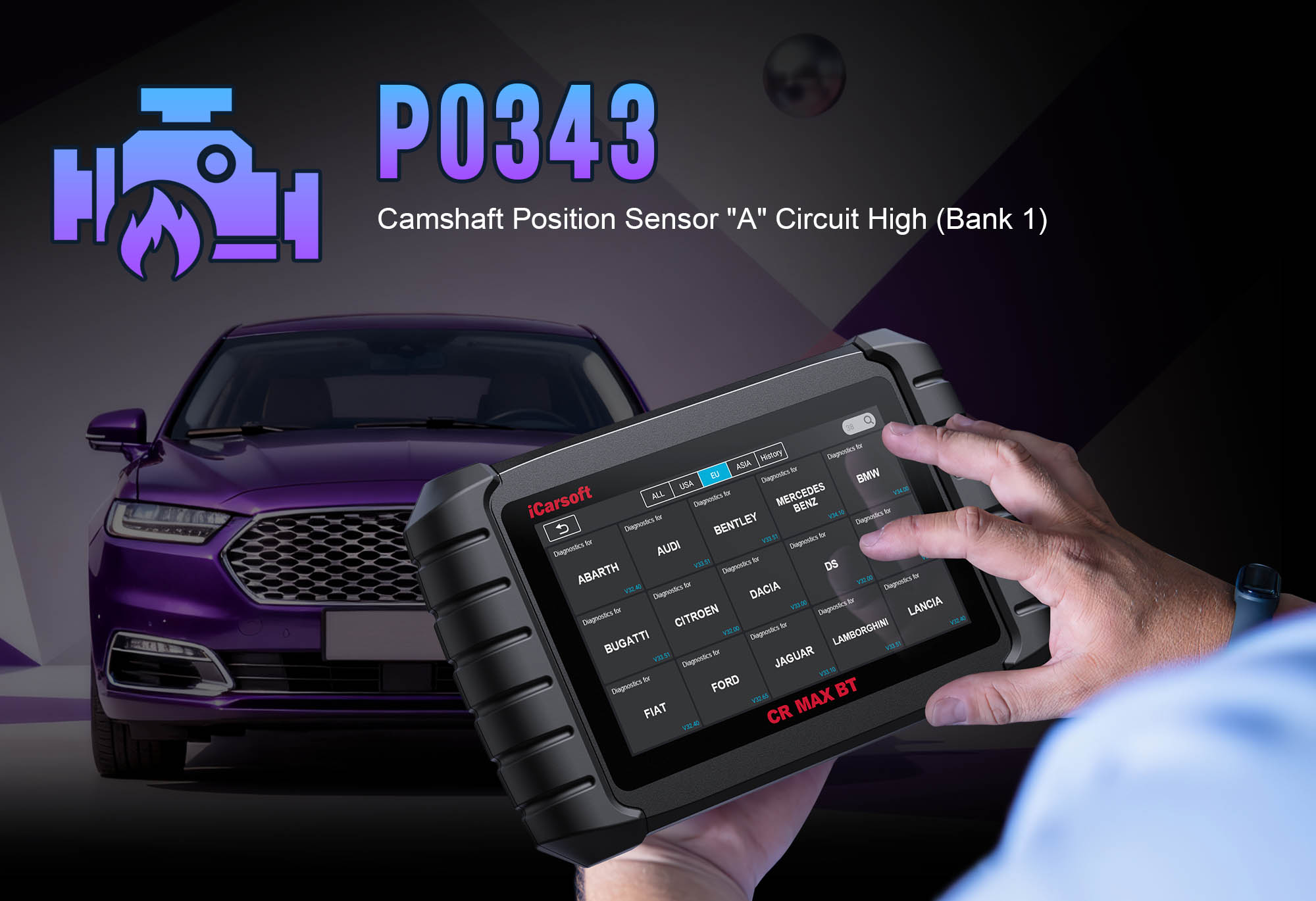Diagnose & Clear P0448 with iCarsoft CR Ultra P
If your vehicle’s check engine light glows persistently and you notice a fuel odor near the rear or failed emissions tests, a diagnostic scan will likely return P0448. This OBD-II code stands for "Evaporative Emission Control System (EVAP) Vent Valve/Solenoid Circuit Malfunction"—a fault targeting the electrical circuit that controls the EVAP vent valve, a critical component in your vehicle’s emissions system. The vent valve regulates airflow into the EVAP system, which traps fuel vapors from the gas tank to prevent them from escaping into the atmosphere. When the circuit malfunctions (due to shorts, corrosion, or a faulty valve), the valve can’t open/close properly, disrupting pressure control and triggering P0448.
Basic scanners might only flag a "vent valve issue" but can’t pinpoint whether the problem is a shorted wire, corroded connector, or failing solenoid—leaving you stuck replacing parts blindly. The iCarsoft CR Ultra P, with its advanced EVAP diagnostics, bi-directional controls, and circuit topology mapping, solves this. Let’s break down how to diagnose and resolve P0448 with precision, using the CR Ultra P’s unique features to restore EVAP functionality and ensure emissions compliance.
Understanding P0448: Causes & Key Symptoms
The EVAP vent valve (often called a solenoid) is mounted near the charcoal canister (typically under the vehicle or in the engine bay). It opens to allow fresh air into the system during normal operation and closes when the Engine Control Module (ECM) runs leak tests (pressurizing the system to check for vapor leaks). P0448 triggers when the ECM detects abnormal electrical activity in the valve’s circuit—such as a short, excessive resistance, or intermittent connectivity—preventing reliable valve operation. Over time, this leads to noticeable issues:
Key Symptoms of P0448
-
Persistent Check Engine Light (CEL): A steady CEL is the primary warning, often accompanied by "EVAP Vent Valve Circuit Malfunction" messages.
-
Fuel Odors: Uncontrolled vapor release or trapped fumes may create a gasoline smell near the rear of the vehicle (where the canister/valve are located).
-
Poor Fuel Economy: Disrupted vapor management throws off the ECM’s fuel trim calculations, reducing mileage by 5–10%.
-
Failed Emissions Tests: The EVAP system can’t pass mandatory leak checks, resulting in inspection failures.
-
Canister or Valve Damage: A stuck valve (due to electrical faults) may overpressurize the canister, causing cracks or internal wear.
Common Causes of P0448
|
Cause
|
Description
|
|
Faulty EVAP Vent Valve/Solenoid
|
Internal coil damage (shorts or excessive resistance) disrupts current flow, preventing proper opening/closing—common after 80,000+ miles.
|
|
Shorted or Damaged Wiring
|
Frayed wires, rodent chews, or moisture intrusion (from road spray) create short circuits in the valve’s harness.
|
|
Corroded/Loose Connector
|
The valve’s 2–3 pin connector (near the canister) accumulates rust, dirt, or oil, causing intermittent or high-resistance connections.
|
|
Blown Fuse or Faulty Relay
|
A dedicated fuse (7.5A–15A) or relay powers the vent valve circuit; failure interrupts power and triggers circuit faults.
|
|
ECM Malfunction
|
Rarely, the ECM’s internal driver for the vent valve fails, sending incorrect voltage signals that mimic circuit issues.
|
Why iCarsoft CR Ultra P Excels at Diagnosing P0448
The CR Ultra P outperforms basic tools with features tailored to EVAP circuit diagnostics—critical for resolving P0448 accurately:
EVAP Circuit Topology Mapping
Visualizes the entire vent valve circuit as a color-coded diagram, highlighting shorts, high resistance, or breaks at a glance.
Bi-Directional Valve Control
Sends open/close commands while monitoring current flow, distinguishing faulty valves from wiring/ECM issues.
Advanced Circuit Testing
Measures voltage/resistance/current in real time, isolating shorts (<5 ohms) or excessive resistance (>50 ohms) basic scanners miss.
Global Vehicle Coverage
Supports 200+ brands and EVAP system types, including 2018+ models with DoIP/CAN-FD protocols.
CR Link VCI Compatibility
Seamless connectivity with modern vehicles, unlike older tools limited to basic OBD-II.
41 Hot Service Functions
Includes EVAP leak tests, valve calibration, and ECM reset—essential for post-repair validation.
Battery & Circuit Health Checks
Built-in battery tests rule out low voltage (a common cause of false circuit faults) before diagnostics.
Step-by-Step: Diagnose P0448 with iCarsoft CR Ultra P
-
Safety First & Initial Inspection
1. Turn off the engine and avoid open flames/sparks near the vehicle (fuel vapors are flammable).
2. Locate components via Component Location > Emissions > EVAP System:
- EVAP Vent Valve: Near charcoal canister (under rear/engine bay) with vacuum line + electrical connector.
- Vent Valve Fuse/Relay: Engine bay/interior fuse box (labeled "EVAP Vent" or "Canister Solenoid").
- Wiring Harness: Loom connecting valve to ECM (routed along chassis).
3. Visual Checks:
- Clean valve connector with electrical contact cleaner; inspect for rust/bent pins.
- Check wiring for frays/burns/rodent damage; repair minor issues with heat-shrink tubing.
- Test fuse with Voltage Test—no voltage = blown fuse (replace with same amperage).
-
Connect Tool & Confirm P0448
Plug CR Ultra P into OBD-II port, pair with CR Link VCI. Select AutoVIN Identify to retrieve EVAP specs (valve resistance, fuse rating, pinouts). Navigate to Engine > Fault Codes > Read Codes to confirm P0448. Tap Code Details for insights (e.g., "Honda Civic: Resistance 60 ohms, Expected 20–30 ohms"). Note related codes (P0440, P0446) and resolve P0448 first.
-
Use Topology Mapping to Pinpoint Faults
Navigate to Engine > Topology Mapping > Emissions > EVAP Vent Circuit. Review the color-coded diagram:
- Green: Healthy components (normal resistance, intact wiring).
- Yellow: High resistance (corroded connector, partial wire damage).
- Red: Shorts or open circuits (failed valve, broken wire).
Focus on red/yellow areas to target further testing.
-
Test Vent Valve & Circuit Integrity
1. Valve Resistance Test: Disconnect valve, multimeter Ohms—20–30 ohms (varies by make); <5 ohms = short; >50 ohms = excessive resistance (replace valve).
2. Circuit Voltage & Current Test: Reconnect connector, ignition "ON" (no start). Monitor Engine > Live Data > EVAP > Vent Valve Circuit: Power wire = 11.5–12.5V (0V = fuse/wire fault); current = 0.5–1A when valve activates (0A = open circuit; >2A = short).
3. Bi-Directional Activation Test: Use Special Functions > Emissions > EVAP Vent Valve Control—send "Open/Close" commands; listen for distinct clicks (no/inconsistent clicks = faulty valve/wiring).
-
Repair or Replace Faulty Components
- Fuse/Relay Replacement: Install OEM-spec fuse (e.g., 10A); replace relay via Part Lookup if no power to valve. Retest if fuse blows again (check for shorted valve).
- Wiring/Connector Repairs: Splice shorted/frayed wires with 18-gauge automotive wire + heat-shrink; replace corroded connectors with OEM pigtails + dielectric grease.
- Vent Valve Replacement: Remove old valve (1–2 bolts), disconnect vacuum line; install OEM-compatible valve (e.g., Dorman 911-089, Bosch 0280142456); torque to 8–10 ft-lbs, reconnect lines/connector.
- ECM Reset: Use Special Functions > Engine > ECU Reset for temporary faults; consult authorized service for persistent ECM issues.
-
Clear P0448 & Validate Repairs
1. Clear Code: Navigate to Engine > Fault Codes > Clear Codes—confirm P0448 deletion.
2. EVAP Leak Test: Run Special Functions > Emissions > EVAP Leak Test—"Pass" confirms system pressure retention.
3. I/M Readiness Check: Drive 50–100 miles (cold starts + highway speeds) to complete EVAP self-tests; use I/M Readiness to verify EVAP monitor is "Ready."
4. Save Reports: Document diagnostics/repairs via History & Report for future reference.
Preventing P0448 Recurrence
-
Quarterly Circuit Checks: Use the tool to test valve resistance and current draw every 15,000 miles—catch early coil wear.
-
Wiring Inspections: Check the harness for damage during oil changes; use topology mapping to spot hidden issues.
-
Fuse Maintenance: Replace the vent valve fuse proactively every 50,000 miles to avoid unexpected failures.
-
Free Updates: Use One-Key Upgrade to add advanced EVAP diagnostic features (e.g., short detection) for 3 years.
Conclusion
P0448’s EVAP vent valve circuit malfunction threatens emissions compliance and fuel efficiency. The iCarsoft CR Ultra P simplifies diagnosis with topology mapping, bi-directional controls, and precise circuit tests, ensuring you fix the root cause—whether a valve, wire, or fuse—without guesswork.
With 200+ brand coverage, CR Link VCI, and 41 service functions, the CR Ultra P is more than a P0448 fix—it’s a long-term investment in emissions system health. Pass inspections, reduce fuel costs, and protect the environment—all with one professional-grade tool.





